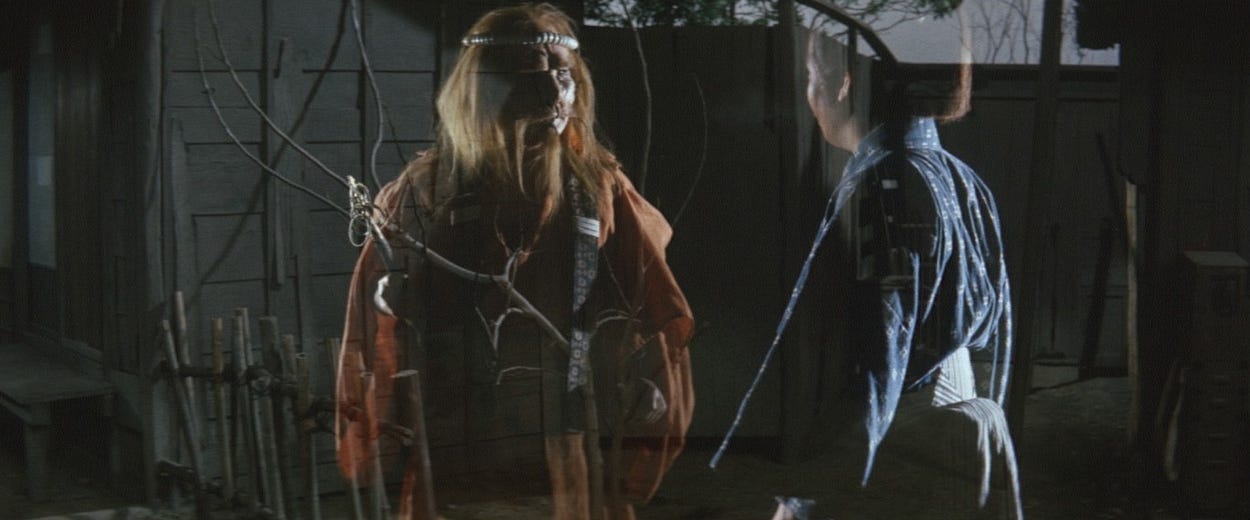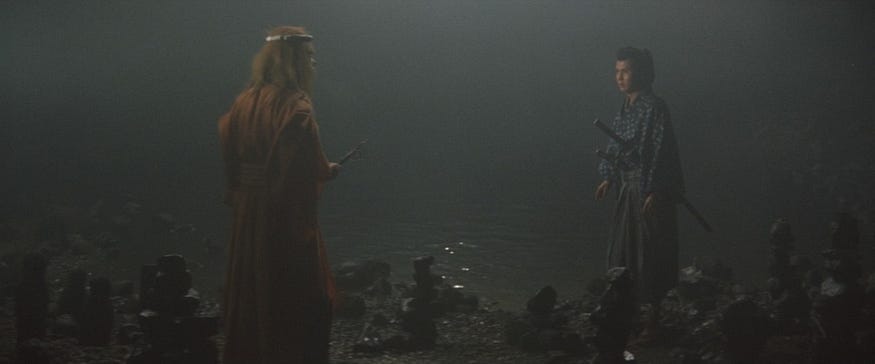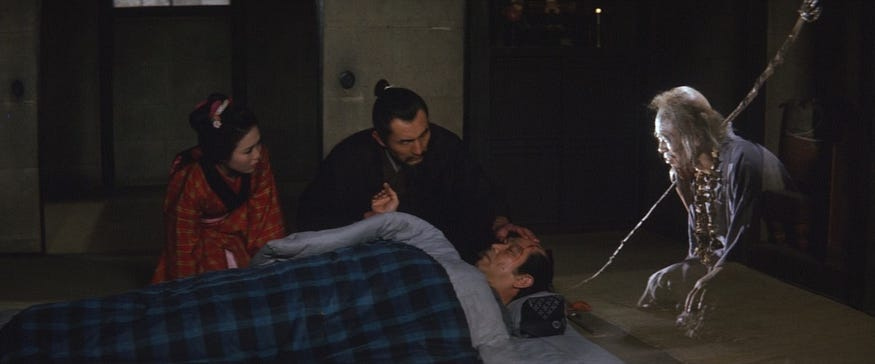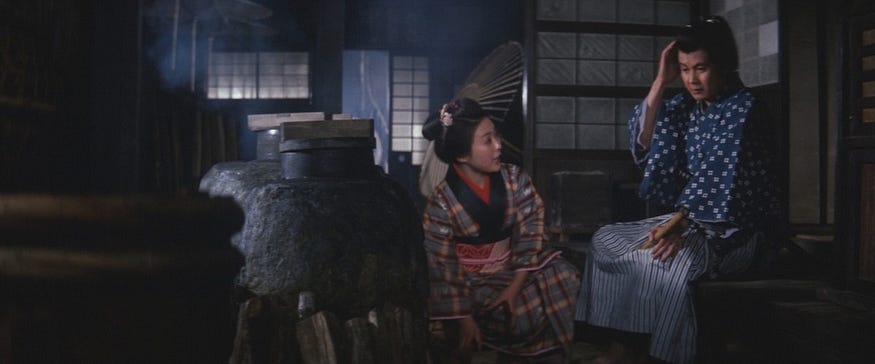The Invisible Swordsman (1970) • Limited Edition Blu-ray [Arrow Video] — a silly supernatural revenge story
A cowardly young fencer becomes invisible thanks to a magic potion.
The Invisible Swordsman / 透明剣士 is an enjoyable piece of hokum when approached in the right frame of mind. Although its niche appeal will not be for everyone, I know there’ll be enthusiasts out there very eager to get their hands on this rarity, making its international debut outside Japan, especially now it’s been carefully restored for release on Blu-ray from Arrow Video. The main reason for it being all but forgotten for the last half-century is down to the technical problems of duplicating such a dark, low-contrast movie set almost entirely at night or in a foggy supernatural hinterland. Certainly, VHS home video was never a viable option, and standard DVD wouldn’t have been good enough either.
The low-light cinematography does create a unique mood and there are a handful of truly beautiful shots. However, one assumes that the more problematic sequences were not intended to be so dark as to obfuscate the action and narrative details. This seems to be a compromise with the requirements of the mechanical in-camera effects, keeping wires unnoticed, hiding technical operators in the shadows, and sometimes to leave dark areas of the screen for superimposed characters to appear. This situates the movie within the tokusatsu genre of Japanese films centred on special effects and marketed mainly for younger audiences.
The Invisible Swordsman was one of the last films for the usually reliable Hiroshi Imai, who’d already shot 60 or so features including some outstanding work on Daiei’s Yōkai Monsters movie series. He’d previously worked with director Yoshiyuki Kuroda on The Great Yōkai War (1968) as well as the excellent Along with Ghosts (1969) which was one of four films showcased on the Yōkai Monsters Collection Blu-ray box set, also available from Arrow.
Regardless of those technical issues, there’s still plenty to enjoy in this fun, family-friendly film with spooks and sword fights that are neither too scary nor too violent. That it was initially released as a double bill with Gamera vs. Jiger / ガメラ対大魔獣ジャイガー (1970) is an indication of the intended demographic, and it retains an appealing innocence of its time.
Young Sanshiro (Osamu Sakai) really isn’t cut out to be a samurai like his father, who insists he train hard at the kendo dojo where he clearly demonstrates his clumsiness and lack of fighting spirit in the opening scenes. He feels that he’s a big disappointment, which makes it even more tragic when his father is killed at the hands of a robber gang known as the Phantom Thieves while on night patrol. It seems that the energy of Sanshiro’s angst and grief are enough to propel him across the threshold as he pursues his father’s ghost through a graveyard and to the banks of Sanzu-no-Kawa, the river of death. He’s just in time to see him board the boat of ‘The God of Death’ and disappear into the dark beyond and is about to wade across the river of no return when a benign yōkai Shokera (Tokio Oki) intervenes.
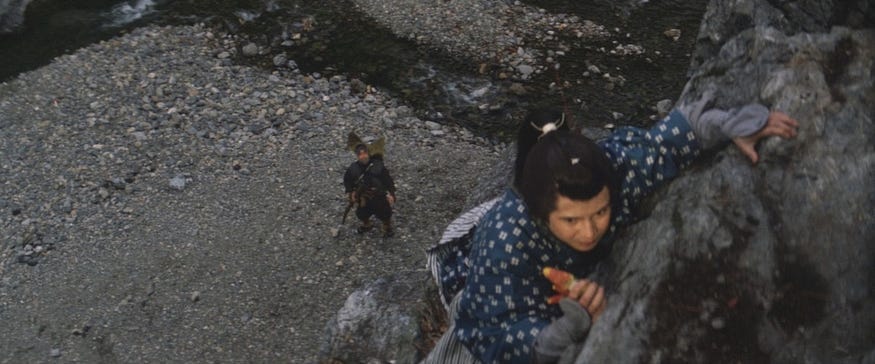
The simple narrative doesn’t waste time before getting to the supernatural stuff! In classic fairytale style, Shokera tells our reluctant hero about a magical potion that will aid him in seeking revenge for his father’s murder. He must collect three medicinal botanicals specific to Japan: a rare type of lily, a magic mushroom that only grows high in the mountains, and a type of seaweed found on a remote and rugged stretch of coast. He must gather these ingredients, mix them together, and boil them all night during a particular phase of the moon and ensure that no one sees him at any point in the process. Shokera doesn’t clearly explain what the resulting elixir will do, but on completion of his task, Sanshiro soon discovers that he’s made a magic potion that can render him invisible.
When he first tries it out, he runs into a rōnin ruffian (Bunshi Katsura) who lusts after local beauty Osusu (Yôko Atsuta) and won’t take no for an answer. However, floating buckets and carts that move on their own soon divert his attentions, and the fight between objects animated by the invisible swordsman and the drunken rōnin is played mostly for laughs.
Now, from here on, there’s a gaping cultural disjoint that means anyone not knowledgeable enough of Japan’s mainstream media of the 1970s just won’t understand what would have been the major draw for the audience of the day. Bunshi Katsura is a celebrity who still hosts television chat shows to this day but was known back then as a popular rakugo performer, which is a form of comedy in which the lone raconteur tells funny stories while sat on a cushion with only a towel or a fan as props.
Here, his character is often accompanied by two ineffectual henchmen played by Kiyoshi Nishikawa and Yasushi Yokoyama, who were the real stars of the movie, being a very popular comedy duo. They were known for performing manzai comedy, which relied on clever wordplay, misinterpretations, and double meanings implied by the sound of the words. Of course, this is almost entirely lost in translation. So, to get an idea of what it may have been like at the time, perhaps imagine the villainous trio being played by Dave Allen with Cannon and Ball or Little and Large as his henchmen!
The staging in the style of bunraku puppet theatre is another cultural connotation that will go over the heads of many foreign viewers. Along with kabuki, bunraku plays have been a form of popular entertainment in Japan since the Edo period. Both can involve ingenious mechanical stage effects to suggest the actions and influences of yōkai, ghosts, and other spirits. But in bunraku, the performers are clearly visible on stage behind the puppets but dressed from head to toe in black, signalling to the audience that they are invisible and are to be ignored. So, the invisible swordsman who really cannot be seen would have been a novelty. I also wonder if some of the crew operating the mechanical effects, animating the objects that float with the use of wires, would have been visible but black-clad. Perhaps that’s why the photography is so dark? Maybe, as an afterthought, it was decided that they should not be visible at all, and so the shadows had to be darkened.
The VFX and the fight choreography may well please younger viewers but aren’t actually that impressive. I mean, just take a look at what was being done decades earlier in James Whale’s adaptation of The Invisible Man (1933) or by Jean Cocteau for La Belle et la Bête (1946). And it was probably for the best that it was too dark to really see what was going on in some of the fight scenes.
The central narrative revolves around Sanshiro trying to track down his father’s killer, who can only be identified by a tattoo on his forearm, while trying to uncover the identities of the Phantom Thieves who, incidentally, dress pretty much like bunraku performers. There is also a subplot concerning a sort of contest between Shokera trying to ensure the wrongdoers get their just deserts and the god of death who doesn’t really care who dies, so long as he ferries some souls across the river. For me, it was the folkloric content that held my interest, although it seems that it wasn’t entirely authentic, being pretty much dreamt-up by screenwriter Tetsurô Yoshida to serve the story.
For example, although there’s ‘The God of Death’, this is probably a simplification for the benefit of succinct translation as there isn’t really a Japanese equivalent of the Grim Reaper. There really wasn’t a concept of a personification of death in Japan’s literature until just a few stories told in the Edo period, such as the play The Love Suicides at Amijima / 心中天の網島 by Chikamatsu Monzaemon, which was performed as both bunraku and kabuki in the early 1720s, and one or two of the supernatural tales compiled in the 1840s for the Picture Book of a Hundred Stories / 絵本百物 by Shunsensai Takehara.
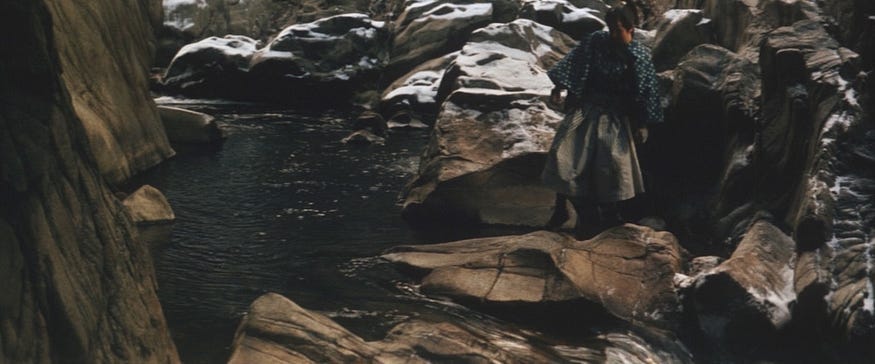
The closest that Japanese mythology gets to a god of death may be Izanami-no-Mikoto, a major goddess involved in the creation story that tells us that she and the god Izanagi created the Japanese archipelago, and together they then parented various lesser deities. In stories of the Shinto religion, she became a Queen of Yomi, the underworld, and is said to call souls into the afterlife.
However, there were several earlier examples of spirits that were strongly associated with death and the afterlife, such as Mrityu-mara, a personification of death in both Hindu and Buddhist traditions that is sometimes attributed with the power to possess a person and guide them toward their death, inspire a death wish within them, or drive them to suicide. In the Edo period, stories containing Shinigami appear, though are not prevalent. These are sometimes referred to as ‘Gods of Death’ that lure souls onto the road that leads to the end of their life…
The first idea of a ‘God of Death’ seems to coincide with contact with foreigners during the Meiji era and are appropriations of Grim Reaper concepts that later borrow from Egyptian and Greek mythology. Which seems to be the case here with the god of death resembling a version of Charon, the ferryman who rows departed souls across the River Styx into the underworld, though it is a tradition in Japan to place coins in a grave for the deceased to pay the ferryman. He’s perhaps an early progenitor for later additions to Japanese folklore that have since proved popular in manga and anime, such as Bleach and Death Note among others, and the live-action adaptation currently streaming on Netflix of Yu Yu Hakusho (2023).
The Invisible Swordsman could be thought of as an early entry into this lineage and may even be of passing interest to a new, younger audience today for this reason. Apparently, it was intended as an origin story for a franchise, but Daiei would soon cease production due to financial problems, and no more movies featuring Sanshiro, the invisible swordsman, were made.
Although it’s by no means a great movie or genre classic, there’s some fun to be had, though I did find myself questioning why Arrow chose to make this movie available as a solo disc. It would have fitted better as part of a box set. Perhaps something along the lines of the Yōkai Monsters Collection but focusing on underseen examples of the tokusatsu genre.
JAPAN | 1970 | 78 MINUTES | 2.35:1 | COLOUR | JAPANESE
Limited Edition Blu-ray Special Features:
High-Definition (1080p) Blu-ray presentation. Necessary to be able to actually see what’s going on in some sequences, which would not have been possible with previous home entertainment formats. It’s still pretty dark throughout, and some of the scenes have compromised on contrast, but one has the impression that this is the best it could ever look given the surviving elements.
Original lossless Japanese mono audio.
Optional NEW translated English subtitles.
NEW audio commentary from author and Asian culture expert Jonathan Clements. An excellent source of otherwise obscure information about the cast and crew and the circumstances of production. Being both a critic and historian, he usefully points out many of the period-correct details, such as the type of thin metal stove Sanshiro uses to boil his elixir of invisibility and the impressive authenticity of the Edo era costumes and samurai haircuts. He shares plenty of cultural context about traditions of bunraku puppet theatre and mansai comedy acts as well as discussing some of the folklore that may have inspired the story. For me, the excellent commentary is the main selling point here.
The Invisible People, a NEW 15-minute interview with film critic Kim Newman on the history of invisibility in cinema. He begins by aligning the tale of a young heir who’s seen as a bit of a disappointment spurred on by a tragic loss with standard superhero fare akin to Peter Parker and Spiderman. Which seems a bit of a stretch but identifies the core tropes that have been around since the earliest fairytales. He then moves on to look at invisibility as symbol and metaphor that functions as a measure of good and evil — what a person does when they cannot be seen is an indication of their moral fibre. Tracing the theme back to the Greek myths he tracks the motif through literature and modern media via H G Wells into pop culture and chats about different invisible characters in cult movies — good and bad, human and supernatural…
Phantom Fighter, a NEW 26-minute interview with film critic and Japanese cinema expert Jasper Sharp. He begins by placing the film within the context of Japan’s post-war cinema landscape and the rise of and fall of Daiei who were approaching bankruptcy when the film was in production. He reminds us of their heyday successes with the likes of Rashomon (1950), Ugetsu (1953), and Gates of Hell (1953) winning international acclaim and opening-up global markets. He then provides a very good decade-by-decade history of the studio before turning his attention more fully to The Invisible Swordsman, discussing it in relation to Daiei’s Yōkai Monsters movies and Gamera kaiju franchises before sharing some quite detailed research about the magic potion mentioned, down to the differences in species of fungi and the health benefits of the specific seaweed mentioned.
Image gallery.
Reversible sleeve featuring original and newly commissioned artwork by Jolyon Yates.
Illustrated collector’s booklet featuring new writing on the film by Zack Davisson. Not available at time of review.
Cast & Crew
director: Yoshiyuki Kuroda.
writer: Tetsurô Yoshida.
starring: Osamu Sakai, Yoko Atsuta, Yasushi Yokoyama, Kiyoshi Nishikawa, Bunshi Katsura, Tokio Oki & Hachirô Oka.
Originally published at https://www.framerated.co.uk on June 22, 2025. All images are used according to the Fair Use doctrine in US & UK law for review, commentary, and education.
¹ This article contains Amazon affiliate links, which earn us a tiny commission to help maintain Frame Rated if you use one to make a purchase — at no extra cost to you.





